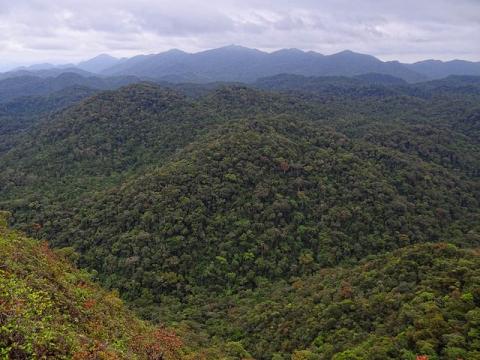The Atlantic Forest in Brazil, seen from a hilltop in Intervales State Park in São Paulo State. Image by Bjørn Christian Tørrissen. License: CC BY-SA 3.0
In the land called Brazil
A great rain forest grows;
But where once stood tall trees
We see sugarcane rows.
The Atlantic Forest, in South America, is huge. It is not as huge as it once was, however. Let's visit a part of that forest which grows in Brazil.
People have had to cut down Atlantic-Forest trees to make room for Brazilian towns. Then they needed to cut down more trees to build their houses.
Besides needing places to live, people need places to work.
- Some of the work places are crop lands where Brazilians grow food.
- Other work places are pasture lands where Brazilians raise cattle.
- It's good for a country to make its own fuel, so Brazilians raise sugar cane (which they turn into ethanol to run their cars).
As the Atlantic Forest loses its trees, the top of the forest - called the canopy - changes. When the tops of too many trees are gone, the canopy is open too far.
When the canopy is open too far, we see sunlight where there used to be shade. When plants needing shade get sunshine instead, they can wither and die. If rainforest plants wither and die, rainforest animals and insects no longer have their food sources.
Animals and birds, on the ground and in trees, have their own space to live. A living space is called a habitat. When the trees are chopped down, habitats change. Sometimes they are totally destroyed.
If their habitats are no longer good places to live and grow, species of birds, plants and animals could disappear in the Atlantic Forest. If they disappear, never to grow or be seen again, they become extinct.
Because the Atlantic Forest is a special place, it has unique plants and animals which live in their own forest habitats. Up to 21 primates and 200 bird species, living in the Atlantic Forest, are found nowhere else on earth. Let's meet some of those special creatures:
- Harpy eagles (which are birds of prey)
- Southern muriqui (also known as woolly spider monkeys)
People who care about Brazil's Atlantic Forest - and its birds, insects, plants and animals - are donating money to protect them. Hopefully that financial assistance will reduce the chances for species' extinction.
Similar efforts are underway in China. Let's investigate what is happening there.


 Back
Back
 Next Chapter
Next Chapter

 Back
Back
 Next Chapter
Next Chapter

